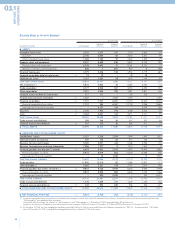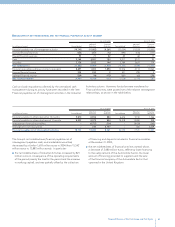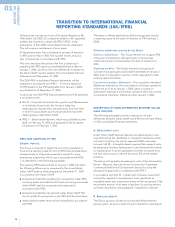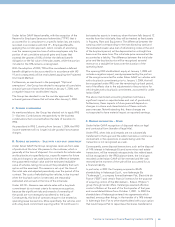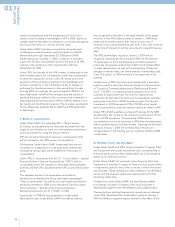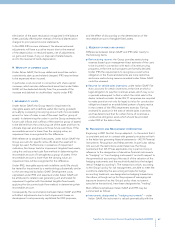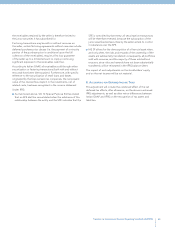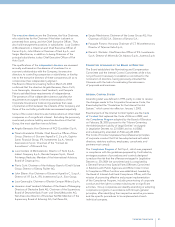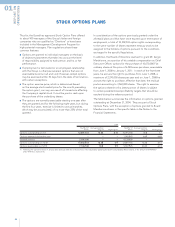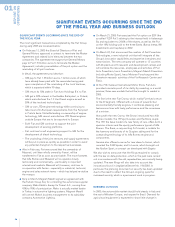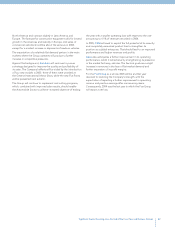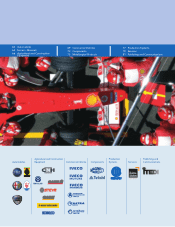Chrysler 2004 Annual Report Download - page 52
Download and view the complete annual report
Please find page 52 of the 2004 Chrysler annual report below. You can navigate through the pages in the report by either clicking on the pages listed below, or by using the keyword search tool below to find specific information within the annual report.
REPORT ON
OPERATIONS
01
50
CORPORATE GOVERNANCE
INTRODUCTION
The Fiat Group adopted and abides by the Corporate
Governance Code, which is mentioned as a model in the
regulations issued by Borsa Italiana (Italian Stock Exchange)
on corporate governance.
Furthermore, as an issuer of financial instruments listed on
various international markets, including the New York Stock
Exchange, Fiat adopted a system of corporate governance in
line with the principles of international best practice and in
particular United States laws, with the inclusion, as appropriate,
of the Sarbanes-Oxley Act.
In accordance with the regulatory requirements of Borsa Italiana,
an “Annual Report on Corporate Governance” is prepared
and made available on the occasion of the annual stockholders
meeting that approves the financial statements. It is also
available in the section “Investor Relations” on the website
www.fiatgroup.com, which also contains all the documents
regarding the Fiat Group corporate governance system.
In compliance with the guidelines issued by Assonime and
Emittenti Titoli S.p.A., this Report is composed of four sections:
the first containing a general description of the structure of
corporate governance, the second that analyzes in detail the
provisions of the Corporate Governance Code, the third that
highlights certain of the more significant aspects of the United
States law, and the fourth that contains summary tables and
Corporate Governance documents of the Fiat Group. The
aspects of significance for this Report on Operations are
illustrated as follows.
DIRECTION AND COORDINATION ACTIVITIES
Fiat S.p.A. is not subject to direction and coordination activities
by companies or entities. Pursuant to Article 2497 bis of the
Italian Civil Code, its subsidiaries, with the exception of
particular cases, have identified Fiat S.p.A. as the entity that
performs direction and coordination activities. This activity
consists in indicating the general strategic and operating
guidelines of the Group and takes concrete form in the
definition and updating of the corporate governance and
internal control model, issuance of a Code of Conduct
adopted by the Group, and elaboration of the general policies
for the management of human and financial resources,
purchasing of factors of production, and communication.
Furthermore, coordination of the Group envisages centralized
management, through dedicated companies, of cash
management, corporate and administrative, internal audit, and
training services.
This allows the subsidiaries, which retain full management and
operating autonomy, to realize economies of scale by availing
themselves of professional and specialized services with
improving levels of quality and to concentrate their resources
on management of their core business.
BOARD OF DIRECTORS
As envisaged in the Articles of Association, the number of
members of the Board of Directors ranges from nine to fifteen.
The Stockholders Meeting held on May 13, 2003 set the number
of members of the Board of Directors at eleven for the 2003,
2004, and 2005 fiscal years, and they shall remain in office until
the date of the Stockholders Meeting that will be called to
approve the financial statements for 2005.
As envisaged in Article 16 of the Company’s Articles of
Association, the representation of the company is invested,
severally, in all executive directors, and as envisaged in Article
12, the Vice Chairman, if appointed, shall act as Chairman if
the latter is absent or prevented from acting. As in the past,
the Board of Directors adopted a model for delegation of
broad operating powers to the Chairman and the Chief
Executive Officer, authorizing them to severally perform all
ordinary and extraordinary acts that are consistent with the
Company’s purpose and not reserved by law or otherwise
delegated or reserved to the Board of Directors itself. In
practice, the Chairman exercises coordination and strategic
guidance within the activities of the Board of Directors, while
the Chief Executive Officer is in charge of the operating
management of the Group.
The Board defined the “Guidelines for Significant
Transactions and Transactions with Related Parties,”
by which it reserved the right to examine and approve in
advance any transaction of significance in the balance sheet,
economic and financial figures, including the most significant
transactions with related parties, and subject all transactions
with related parties to special criteria of substantial and
procedural fairness.
Therefore, decisions regarding significant transactions are
excluded from the mandate granted to executive directors.
The term “significant transactions” refers to those transactions
that in and of themselves require the company to inform the
market thereof, in accordance with rules established by market
supervisory authorities.
When the Company needs to execute significant transactions,
the executive directors shall provide the Board of Directors
reasonably in advance with a summary analysis of the strategic
consistency, economic feasibility, and expected return for the
Company.
Decisions regarding the most significant transactions with
related parties are also excluded from the mandate granted
to executive directors, with all decisions being subject to special
rules of substantial and procedural fairness and disclosure to
the Board.
The Board is comprised by three executive directors and
eight non-executive directors – that is, who do not hold
delegated authority or perform executive functions in the
Company or the Group – five of whom are independent.


